
When it comes to home improvement and renovation projects, paint is often the key element that ties everything together. Choosing the right type and color of paint can completely transform a space, but it’s not just about the aesthetics. Calculating the amount of paint needed for a project is crucial for budgeting and planning purposes. In this article, we will delve into all the important factors involved in paint calculation, from understanding the different types of paint to determining the appropriate amount for each project. Whether you’re a DIY enthusiast or a professional contractor, having a thorough understanding of paint calculation will help you achieve successful and cost-effective results.
Paint calculation | calculator for how much paint do I need

Paint calculation is an essential aspect of any construction or renovation project. As a civil engineer, it is important to accurately estimate the amount of paint needed for a project in order to avoid any excess or shortage of materials. This will not only save time and money but also ensure a smooth and efficient painting process.
The first step in calculating paint quantity is to determine the surface area that needs to be painted. This can be done by measuring the length and height of each wall, door, and window in the area. Once all the measurements have been taken, the total surface area can be calculated by multiplying the length and height of each surface and then adding them together.
After obtaining the surface area, the next step is to determine the paint coverage rate. This refers to the square footage that can be covered by one gallon of paint. The coverage rate can vary depending on the type and quality of paint used, the surface texture, and the application method. In general, high-quality paint with a smooth texture and a roller application will have a higher coverage rate compared to low-quality paint with a rough texture and brush application.
To calculate the paint quantity, divide the total surface area by the paint coverage rate. For example, if the total surface area is 1000 square feet and the paint coverage rate is 350 square feet per gallon, then the total number of gallons needed would be 1000/350=2.86 gallons. In this case, it is advisable to round up the number to the nearest whole gallon, so 3 gallons of paint would be required for this project.
Apart from the surface area and paint coverage rate, there are a few other factors that can affect the paint quantity needed. These include the number of coats required, the paint color, and the type of surface being painted. Different colors may require more coats to achieve full coverage, while a rough surface may require more paint due to its higher absorption rate.
Fortunately, there are various online paint calculators available that can make this process easier and more accurate. These calculators take into account all the factors mentioned above and provide a precise estimate of the paint quantity needed for a project. They also allow the user to input specific measurements and details, making them a valuable tool for civil engineers and other construction professionals.
In conclusion, paint calculation is a crucial aspect of any construction project. As a civil engineer, it is important to have a clear understanding of the surface area, paint coverage rate, and other factors that can affect the total paint quantity needed. By using accurate measurements and reliable paint calculators, this can be achieved, saving both time and resources in the process.
Paint calculation formula for exterior and interior painting

Paint calculation formula is an important aspect of any painting project, as it helps to estimate the required quantity of paint for both the interior and exterior of a building. As a civil engineer, proper paint calculation is essential to ensure that there is no wastage of materials and to stay within the project budget.
The formula for paint calculation may vary depending on the type and brand of paint as well as the surface to be painted. However, the basic formula remains the same and can be applied to both interior and exterior painting projects.
For Exterior Painting:
Step 1: Measure the dimensions of the walls to be painted in meters (m). For example, if the length of a wall is 10m and the height is 3m, then the total area to be painted is 10m x 3m = 30 square meters (m²).
Step 2: Calculate the total area of all the walls to be painted by adding up the individual areas. For instance, if there are two walls with the same dimensions, then the total area to be painted is 30m² + 30m² = 60m².
Step 3: Determine the paint coverage rate. This information is usually provided by the manufacturer and is expressed as the number of square meters that can be covered by one liter of paint. For example, if the paint coverage rate is 10m² per liter, then one liter of paint will cover an area of 10m².
Step 4: Calculate the required quantity of paint by dividing the total area by the paint coverage rate. Using the example above, 60m² of wall area will require 60m²/10m² per liter = 6 liters of paint.
Step 5: Add an additional 10-15% to the calculated amount to account for wastage and touch-ups. In this case, the total amount of paint required will be 6 liters + 0.9 liters (15% of 6 liters) = 6.9 liters.
For Interior Painting:
Step 1: Measure the dimensions of the walls and ceiling to be painted in feet (ft). For example, if the length of a wall is 10ft and the height is 8ft, then the total area to be painted is 10ft x 8ft = 80 square feet (ft²).
Step 2: Calculate the total area of all the walls and ceiling to be painted by adding up the individual areas. For instance, if there are three walls and one ceiling with the same dimensions, then the total area to be painted is 80ft² + 80ft² + 80ft² + 80ft² = 320ft².
Step 3: Determine the paint coverage rate. This information is usually provided by the manufacturer and is expressed as the number of square feet that can be covered by one gallon of paint. For example, if the paint coverage rate is 400ft² per gallon, then one gallon of paint will cover an area of 400ft².
Step 4: Calculate the required quantity of paint by dividing the total area by the paint coverage rate. Using the example above, 320ft² of wall and ceiling area will require 320ft²/400ft² per gallon = 0.8 gallons of paint.
Step 5: Add an additional 10-15% to the calculated amount to account for wastage and touch
How much a gallon of paint cover?
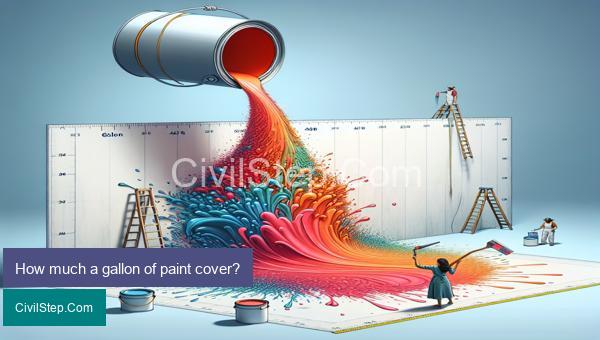
A gallon of paint is a common unit of measurement used in the construction industry. It is specifically used to measure the amount of paint needed to cover a certain area. The coverage of a gallon of paint can vary depending on the type of paint, the condition of the surface, and the method of application. As a civil engineer, it is important to understand the coverage of paint in order to accurately estimate the amount of paint needed for a project.
In general, a gallon of paint can cover an average of 350-400 square feet of a smooth surface with one coat. This coverage rate is based on the assumption that the paint is applied evenly with good quality tools. However, it is essential to note that not all paints have the same coverage rate. Different types of paint, such as primer, flat, gloss, and high-gloss, have varying thicknesses, resulting in different coverage rates.
Additionally, the condition of the surface can also affect the coverage of a gallon of paint. A rough or porous surface will require more paint to cover the same area compared to a smooth surface. This is because the surface will absorb more paint, resulting in a thinner coat and requiring additional paint to achieve the desired coverage.
The application method also plays a significant role in the coverage of a gallon of paint. When applying paint with a brush or roller, the coverage rate may vary depending on the skill of the applicator. Inexperienced painters may use more paint than necessary, resulting in a lower coverage rate. On the other hand, using a sprayer can provide a more consistent and even coverage, resulting in a higher coverage rate.
It is also essential to consider the number of coats needed when estimating the amount of paint required for a project. In most cases, two coats of paint are needed to achieve full coverage and a professional finish. However, certain types of paint may require more or fewer coats, which can affect the coverage rate.
In conclusion, the coverage of a gallon of paint can vary, ranging from 350-400 square feet on average. As a civil engineer, understanding the factors that can affect paint coverage is crucial to accurately estimate the amount of paint needed for a project. Consider the type of paint, condition of the surface, application method, and number of coats when calculating the coverage rate of a gallon of paint.
How much does a 5 gallon of paint cover?

A 5 gallon can of paint is a common size for residential and commercial use. This amount of paint can cover a significant area, but the coverage will vary depending on several factors, including the application method, surface type, and paint quality.
On average, a 5 gallon can of paint can cover anywhere from 1,500 to 2,500 square feet. However, this estimation is based on the assumption that the paint will be applied to a smooth, non-porous surface with one coat. In reality, most surfaces require two coats of paint for an even and full coverage.
It is important to note that the type of paint also plays a significant role in determining the coverage of a 5 gallon can. Latex or water-based paints typically have a higher coverage rate compared to oil-based paints. In general, high-quality paints tend to have better coverage and require fewer coats for an even finish.
When it comes to application, using a roller is the most efficient method for coverage, while a brush may require more paint and multiple coats. Factors such as the thickness of the application and the painter’s technique can also affect the coverage.
The type of surface being painted can also impact coverage. Smooth surfaces like drywall and metal require less paint compared to rough surfaces like bare wood or textured walls. Additionally, porous surfaces tend to absorb more paint, requiring a larger quantity to achieve the desired coverage.
To determine the actual coverage of a 5 gallon can of paint, it is essential to read the manufacturer’s recommendations and information on the can. Most paint cans will provide an estimated coverage rate based on the factors mentioned above. It is also helpful to consult with a paint specialist or your local hardware store for specific guidance.
In conclusion, a 5 gallon can of paint can cover anywhere from 1,500 to 2,500 square feet, depending on various factors. Before starting a project, it is crucial to consider the application method, surface type, and paint quality to determine the true coverage of a 5 gallon can. Accurately estimating the coverage will help in determining the right amount of paint needed, avoiding any excess or shortage.
What area does 1 litre of paint cover?
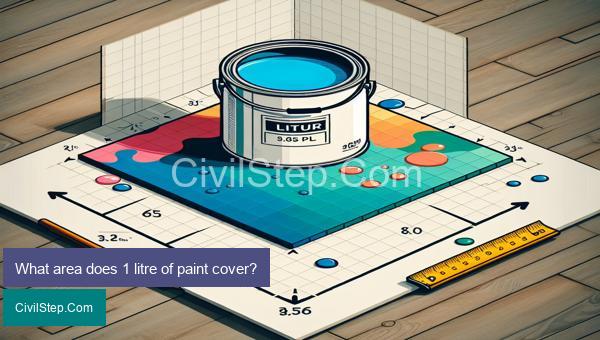
The coverage of paint is an important factor to consider when estimating the amount of material needed for a painting project. One commonly used unit for measuring paint quantity is litres. However, the coverage area of paint may vary depending on the type of paint, the application method, surface porosity, and other factors.
On average, 1 litre of paint can cover approximately 10-12 square meters of surface area. This, however, is a general estimate and may not hold true for all paints. The coverage area of paint can range from 8-14 square meters per litre, depending on the factors mentioned above.
One of the main factors that affect the coverage area of paint is its type. Different types of paints have different levels of solid content, which can impact its coverage area. For example, oil-based paints have a higher solids content, resulting in better coverage compared to water-based paints.
The surface porosity is another critical factor that affects the coverage area of paint. Porous surfaces, such as concrete or wood, will absorb more paint and require a larger amount of material to achieve an even coverage. On the other hand, smooth surfaces, like metal or glass, will have lower porosity and will require less paint.
The application method also plays a role in the coverage of paint. Generally, roller and spray methods provide better coverage compared to a brush. The texture of the surface can also affect the coverage area of paint. Rough surfaces, such as brick or stucco, will require more paint to achieve complete coverage.
It is essential to consider the coverage area of paint when planning for a painting project to avoid under or overestimating the required amount of material. To determine the coverage area of a specific paint, manufacturers usually provide information on the product label or online. It is recommended to use this information as a guide and always account for potential variations based on the factors mentioned.
In conclusion, the coverage area of 1 litre of paint can cover approximately 10-12 square meters on average. However, this can vary depending on the type of paint, application method, surface porosity, and texture. Accurately estimating the coverage area of paint is crucial for a successful and cost-effective painting project.
How much area is covered by 1 litre of paint
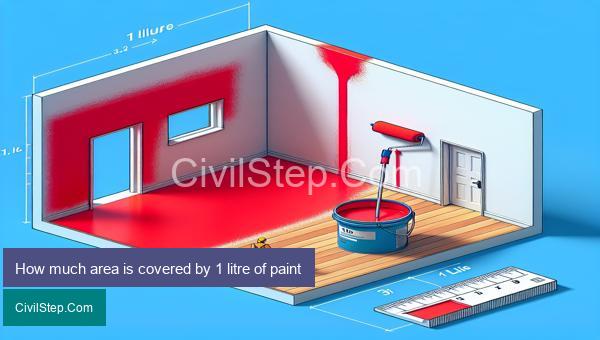
One litre of paint typically covers an area of about 10-12 square meters, depending on the type of surface being painted and the thickness of the paint application.
The coverage area also varies based on the quality and type of paint, as well as the method of application. For example, a high-quality paint with higher pigmentation will cover a larger area than a lower-quality paint with lower pigmentation.
In addition, painting on a smooth and even surface will require less paint compared to painting on a rough or textured surface. Painting with a brush will also result in a thinner layer of paint, while using a roller will provide better coverage with a thicker layer of paint.
It is important to accurately calculate the area to be painted and the amount of paint needed in order to avoid wastage or running short of paint. This can be done by measuring the length and width of the surface to be painted and multiplying them to get the total square meters. The coverage area of the paint can then be divided by the total area to determine the amount of paint needed.
Furthermore, it is recommended to apply two coats of paint for a better finish and longer durability, which will require twice the amount of paint compared to a single coat.
In summary, the coverage area of one litre of paint is approximately 10-12 square meters, but it is important to consider various factors that may affect the actual coverage. Consulting with a paint expert or carefully reading the instructions on the paint can will also provide guidance on the specific coverage of a particular paint.
What area does 5 litres of paint cover?
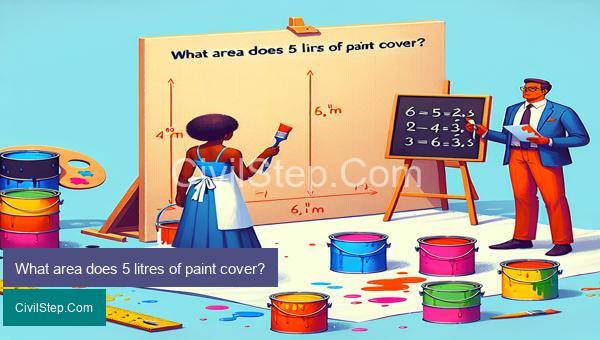
As a civil engineer, I have extensive knowledge in construction materials and their applications. An important component of any construction project is paint, which not only adds aesthetic value but also protects the surface it covers. Paint is typically sold in quantities such as gallons or litres, and one common question that arises is what area can be covered by a certain amount of paint, such as 5 litres.
The answer to this question depends on various factors such as the type of paint, surface type, and method of application. Generally, manufacturers provide information on the coverage area on the paint can, but it is important to understand how this calculation is made.
The coverage area of paint is determined by the spreading rate. This refers to the amount of paint needed to cover a certain area. It is usually measured in square meters per litre (m2/L) or square feet per gallon (ft2/gal). The spreading rate is established by conducting tests in laboratory conditions, considering factors such as the viscosity of the paint, surface porosity, and application method.
Different types of paint have different spreading rates. For example, a high-quality acrylic paint may have a spreading rate of 10 m2/L, while a low-quality emulsion paint may have a rate of only 5 m2/L. This means that 1 litre of the acrylic paint can cover an area of 10 square meters, while the same amount of emulsion paint can only cover half of that.
Another important factor that affects the coverage area of paint is the surface type. A smoother surface like drywall or plaster may require less paint compared to a more uneven surface such as brick or concrete. This is because the surface porosity affects how much paint is absorbed and how evenly it spreads. In general, a rougher surface will require more paint to achieve the same coverage.
Moreover, the method of application also plays a significant role in determining the coverage area. Using a roller or brush may result in thicker, more consistent coats compared to spraying, which may produce a thinner and less even layer. This could affect the spreading rate and ultimately the coverage area of the paint.
In conclusion, the exact area that 5 litres of paint can cover cannot be determined without considering the type of paint, surface type, and application method. However, as a general guideline, 5 litres of paint can cover approximately 50 square meters of a smooth surface with a high-quality paint and careful application. It is always recommended to consult the manufacturer’s instructions and conduct a small test patch before calculating the exact amount of paint needed for a project.
How much paint is needed for a 12×12 room?
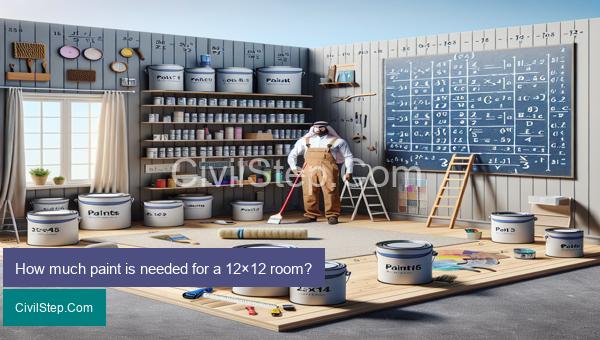
Painting a room is a popular home renovation project that can transform the look and feel of a space. As a civil engineer, I have overseen many painting projects and have a good understanding of the materials and quantities needed for a successful paint job. In this article, I will discuss how much paint is needed for a 12×12 room and factors that can affect the amount of paint required.
The first step to determining the amount of paint needed for a room is to calculate the square footage of the walls. A 12×12 room has a total area of 144 square feet (12×12=144). However, this does not take into account the doors, windows, or any other openings in the room. These areas should be subtracted from the total square footage to get a more accurate estimation.
For a standard 12×12 room with two doors (20 square feet each) and one window (15 square feet), the total square footage would be 144-20-20-15= 89 square feet. Keep in mind that this is for the walls only, and does not include the ceiling or any extra features like crown molding or baseboards.
The next factor to consider is the type and quality of paint being used. Different brands and types of paint have different coverage rates, which is the amount of surface that one gallon of paint will cover. High-quality, premium paints typically have a higher coverage rate, while lower quality paints may require multiple coats to achieve the desired finish. Always check the paint manufacturer’s guidelines for their specific coverage rate.
For a 12×12 room, it is safe to assume that one gallon of paint should cover approximately 300-350 square feet. Using our example from before, with a total square footage of 89 square feet, it would require approximately 0.3 – 0.4 gallons of paint. Keep in mind, this is only for one coat of paint. If multiple coats are needed, then the amount of paint needed will increase accordingly.
Other factors that can affect the amount of paint needed include the texture of the walls and the desired finish. Textured walls tend to require more paint as the texture creates more surface area to cover. Additionally, if a glossy or reflective finish is desired, it may require more coats of paint to achieve a smooth, even finish.
Another important consideration is the color of the paint. Darker colors tend to require more coats of paint than lighter colors to achieve full coverage. It is always a good idea to consult with a paint professional to determine the specific coverage rates and number of coats needed for your chosen paint color.
In conclusion, the amount of paint needed for a 12×12 room can vary based on factors such as the square footage of the walls, type and quality of paint, texture of the walls, desired finish, and the color of the paint. It is always best to consult with a professional or carefully follow the manufacturer’s guidelines to ensure you have enough paint for your project. With proper planning and consideration of these factors, you can achieve a beautiful new look for your 12×12 room.
How much paint is needed for a 10×10 room?

As a civil engineer, I am often tasked with estimating quantities for construction projects. Calculating the amount of paint needed for a 10×10 room is a common request that requires careful consideration of various factors.
The first step in determining the amount of paint needed is to calculate the surface area of the room. A 10×10 room has a perimeter of 40 feet and a total area of 100 square feet. However, this calculation does not account for windows, doors, or other openings in the room. To get a more accurate estimation, the area of these openings should be subtracted from the total area.
Next, the type of paint and its coverage rate must be taken into account. Paint coverage rates are usually given in square feet per gallon, and this varies depending on the type of paint and its brand. Standard latex paint, for example, has an average coverage rate of 350-400 square feet per gallon. This means that one gallon of paint can cover a 10×10 room with some leftover for touch-ups.
In addition to the type of paint, the condition of the walls also affects the coverage rate. If the walls are new or have never been painted before, they may require more paint to achieve the desired coverage. On the other hand, if the walls are rough or damaged, they may need additional coats of paint, which would increase the amount of paint needed.
Another factor to consider is the number of coats of paint desired. In most cases, two coats of paint are needed to achieve a uniform and long-lasting finish. Therefore, the amount of paint needed should be doubled to cover two coats. It is always recommended to have some extra paint on hand for touch-ups or unexpected needs.
It is also essential to consider the paint finish, such as flat, eggshell, or semi-gloss, as this can affect the coverage rate. For example, a glossier finish may require more paint than a flat finish.
To summarize, to determine how much paint is needed for a 10×10 room, several factors need to be considered, including the room’s surface area, paint coverage rate, wall condition, and desired number of coats and finish. As a civil engineer, it is important to carefully estimate the amount of paint needed to avoid excess waste and unnecessary costs.
1 litre of paint covers how many square meter
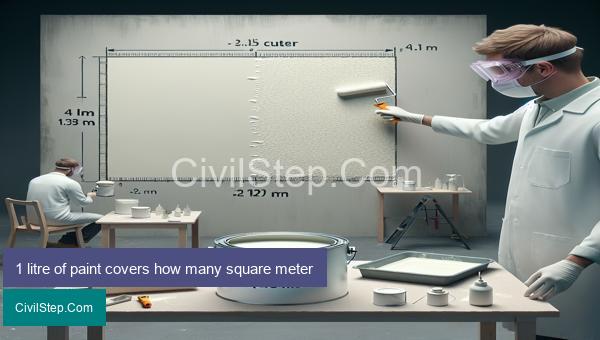
The amount of paint needed to cover a certain area depends on various factors such as the type of surface, the quality of the paint, and the thickness of the application. However, on average, 1 litre of paint can cover approximately 10 square meters of surface area.
This estimation is based on using a quality paint and applying it with a paint roller or brush. If a lower quality paint or a sprayer is used, the coverage may be less. Also, if the surface is rough or porous, it may require more paint to achieve adequate coverage.
It is important to read the instructions on the paint can and calculate the coverage area based on the manufacturer’s guidelines. This will help ensure that the right amount of paint is purchased for the project.
Furthermore, it is recommended to consider buying slightly more paint than the calculated amount to account for any unexpected losses or touch-ups that may be needed.
In conclusion, 1 litre of paint can cover approximately 10 square meters of surface area, but this may vary depending on the specific project and materials used. It is always best to consult the manufacturer’s instructions and guidelines for accurate coverage estimations.
1 litre of paint covers how many square feet

One litre of paint typically covers approximately 100 square feet of surface area. However, this may vary depending on the type of paint, the texture of the surface, and the method of application. For example, rough or porous surfaces may require more paint to achieve adequate coverage, while smooth surfaces may require less. It is always important to refer to the manufacturer’s instructions for the recommended coverage rate for the specific paint being used. Additionally, factors such as multiple coats or thick application may also affect the coverage rate. Therefore, it is best to calculate the coverage based on the specific circumstances and conditions of the project.
20 litre of paint covers how many square meter
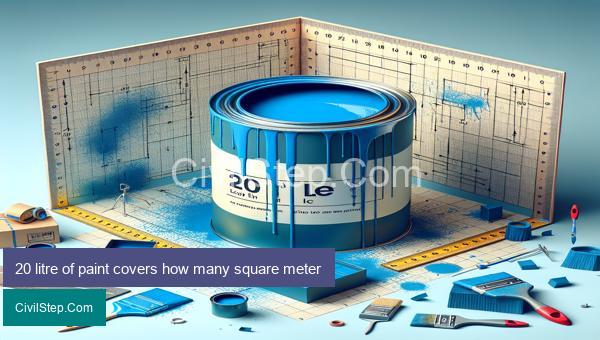
The amount of square meters that 20 litres of paint can cover is dependant on various factors such as the type of paint, surface porosity, and application method. However, a general estimate for coverage can be determined based on the paint’s theoretical coverage rate.
The theoretical coverage rate, also known as the theoretical spread rate, is the amount of surface area that a litre of paint can cover in one coat, without accounting for any wastage or additional coats. This rate is typically listed on the paint can or manufacturer’s website and is measured in square meters per litre.
On average, a litre of paint can cover approximately 10-12 square meters in one coat. This means that 20 litres of paint can cover approximately 200-240 square meters in one coat. This is assuming a standard coverage rate of 10-12 square meters per litre and a single coat application.
However, it is important to note that the actual coverage achieved may be lower than the theoretical rate due to factors such as surface texture, uneven application, and paint wastage. For example, a rough or textured surface may require more paint to achieve the desired coverage, and overspray or spillage can also result in a lower coverage rate.
Additionally, different types of paint may have different coverage rates. For example, a thick and highly pigmented paint may have a higher coverage rate compared to a thinner and less pigmented one.
Therefore, it is best to refer to the specific paint manufacturer’s guidelines for accurate coverage estimates. It is also recommended to purchase a slightly larger amount of paint than required to account for any potential wastage or need for additional coats.
In conclusion, while 20 litres of paint can generally cover approximately 200-240 square meters in one coat, the actual coverage achieved may vary based on various factors and it is best to refer to the manufacturer’s guidelines for accurate estimates.
20 litre of paint covers how many square feet
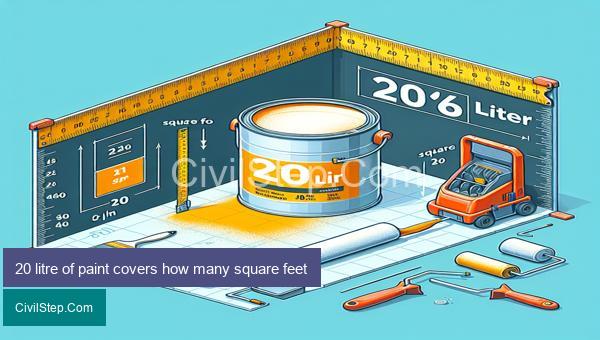
The coverage of 20 litres of paint depends on various factors such as the type of paint, the surface being painted, and the technique used for application. However, on average, 20 litres of paint can cover approximately 900-1000 square feet of surface area.
The coverage capacity of paint is usually indicated on the label or can of the paint. It is typically measured in square feet per gallon (sq ft/gal) or square meters per liter (sq m/L). This information is essential for estimating the amount of paint needed for a specific project.
The type of paint also plays a significant role in determining the coverage capacity. For instance, latex or water-based paints tend to cover more surface area than oil-based paints. This is because they have a higher solids content and can be spread thinner while still achieving the desired coverage.
The surface being painted also affects the coverage capacity of paint. A smooth and even surface will require less paint compared to a surface with imperfections or rough textures. In such cases, more paint will be needed to cover the same area due to the greater absorption and uneven distribution of the paint.
The method of application also impacts the coverage capacity of paint. Using a roller or sprayer will provide better coverage compared to using a brush. However, this may also result in a thinner coat of paint, therefore requiring more coats for complete coverage.
In conclusion, the coverage of 20 litres of paint can vary depending on various factors. However, on average, it can cover approximately 900-1000 square feet of surface area. It is always best to consult the paint manufacturer’s label for more specific information regarding coverage capacity. Additionally, conducting a small test patch can help determine the exact amount of paint needed for a particular project.
5 litre of paint covers how many square meter

5 litres of paint can cover approximately 50 square meters. This coverage may vary depending on the type of surface being painted and the thickness of the paint application.
In general, the coverage of paint is determined by its spreading rate, also known as the theoretical coverage. It is the estimated area that a specific amount of paint (in this case, 5 litres) can cover at a specific thickness, usually measured in microns.
The formula for calculating coverage is:
Coverage = (Paint volume in litres/Spreading rate) x 100
For example, if the spreading rate of a particular paint is 10 square meters per litre, then 5 litres of that paint would cover 50 square meters (5/10 x 100 = 50).
However, it is essential to note that this is only an estimate and the actual coverage may vary depending on factors such as the type of surface, texture, and porosity. Also, thicker application or multiple coats of paint may reduce the coverage area.
In general, smoother and less porous surfaces, such as drywall or plaster, require less paint compared to rough and porous surfaces like bricks or concrete.
Moreover, different types of paint may have different spreading rates. For instance, a high-quality paint with a higher concentration of pigments may have a lower spreading rate compared to a cheaper paint with less pigment concentration.
Therefore, it is always important to refer to the manufacturer’s guidelines and conduct a test patch before painting to get a more accurate estimate of the coverage area of the paint. This will help ensure that you have enough paint for the desired area and avoid any wastage.
5 litre of paint covers how many square feet

The coverage area of 5 litres of paint can vary greatly depending on factors such as the brand, color, and type of paint being used, as well as the surface being painted. Typically, the average coverage area of 5 litres of paint ranges from 400 to 500 square feet, assuming a single coat application on a smooth and well-primed surface.
However, it is important to note that this is just an estimate and the actual coverage area may differ. For example, a high-quality paint may have a better coverage rate compared to a cheaper or lower-quality paint. The application method and tools used can also affect the coverage area. Using a roller or brush may result in a slightly higher coverage compared to using a sprayer.
Also, it is important to consider the porosity and texture of the surface being painted. A more porous surface may require more paint to achieve the desired coverage, while a smoother surface may require less paint.
To determine the exact coverage area of 5 litres of paint, it is best to refer to the manufacturer’s instructions or perform a test patch on the surface to be painted. This will give a more accurate estimate of the paint’s coverage rate and help in determining the amount of paint needed for a specific project.
In conclusion, 5 litres of paint can cover an average of 400-500 square feet, but the actual coverage area may vary depending on various factors. It is important to carefully consider these factors when purchasing paint and always refer to the manufacturer’s instructions for the best results.
10 litre of paint covers how many square meter
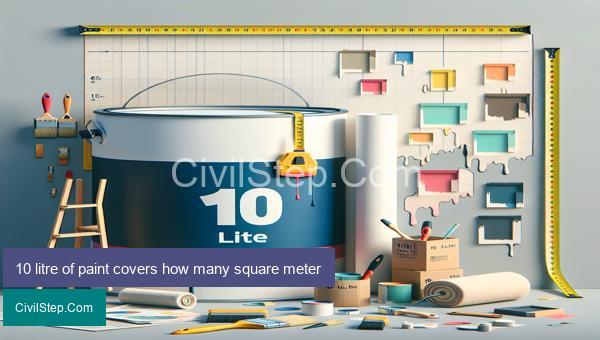
The coverage of a 10 litre can of paint depends on various factors such as the type of paint, surface porosity, and method of application. In general, a 10 litre can of paint can cover an area of approximately 80-100 square meters.
For example, if we assume that the paint has a spread rate of 8-10 square meters per litre, then a 10 litre can will cover an area of 80-100 square meters. This is a rough estimate and can vary based on the above-mentioned factors.
If the surface is smooth and non-porous, the coverage may increase, while a rough or porous surface may require more paint to cover the same area. Similarly, the method of application, whether by brush, roller, or spray can also affect the coverage.
To accurately determine the coverage of a 10 litre can of paint, it is best to refer to the product label or consult with the manufacturer. They can provide specific information on the coverage based on their product and its application.
In summary, a 10 litre can of paint can cover approximately 80-100 square meters, but actual coverage may vary depending on the type of paint, surface condition, and application method. It is important to follow the manufacturer’s guidelines for best results and to avoid any wastage of paint.
10 litre of paint covers how many square feet
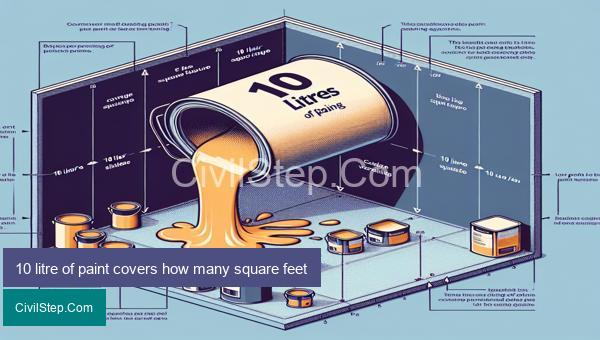
The amount of square footage that 10 litres of paint can cover varies depending on the type of paint, the surface being painted, and the application method. In general, 10 litres of paint can cover approximately 800-1,200 square feet of surface area.
For example, if you are using a high-quality latex paint with a roller to paint interior walls with a smooth surface, 10 litres of paint can cover up to 1,200 square feet. However, if you are using a lower quality paint or painting a textured surface, the coverage may be less and you may need more paint to achieve the same coverage.
If you are using a high-quality paint for exterior painting on a smooth surface, 10 litres of paint can cover approximately 800 square feet. However, if the surface is rough or porous, you may need more paint to achieve the desired coverage.
It is important to note that the coverage may also vary depending on the number of coats applied. For example, if you are using a light-colored paint to cover a darker surface, you may need multiple coats to achieve optimal coverage and color.
Additionally, the type of paint application method can also affect the coverage. Using a roller or brush will typically result in more coverage compared to using a spray gun.
It is always recommended to refer to the manufacturer’s instructions for accurate coverage information specific to the paint being used. It is also a good idea to purchase a bit more paint than what is estimated to ensure you have enough to complete the project.
In summary, 10 litres of paint can cover approximately 800-1,200 square feet, depending on factors such as paint type, surface, application method, and number of coats. It is always best to consult with a professional or refer to the manufacturer’s instructions for specific coverage information for your project.
Conclusion
In conclusion, understanding the various factors that go into calculating the amount of paint needed for a project can save time, money, and ensure a successful outcome. By carefully measuring the surface area, considering the type of paint and its coverage rate, as well as factoring in multiple coats, one can accurately estimate the amount of paint needed. Additionally, taking into account any special considerations, such as porous surfaces or intricate designs, can further refine the calculation. Whether it’s a small touch-up or a large renovation, having a thorough understanding of paint calculation can greatly benefit any project. So the next time you embark on a painting project, remember to carefully calculate your paint needs for a smooth and efficient process.
